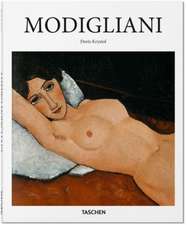Visions of the Human: Art, World War I and the Modernist Subject
Autor Tom Slevinen Limba Engleză Hardback – 27 mai 2015
Preț: 777.06 lei
Preț vechi: 1114.84 lei
-30% Nou
Puncte Express: 1166
Preț estimativ în valută:
148.69€ • 155.24$ • 123.06£
148.69€ • 155.24$ • 123.06£
Carte tipărită la comandă
Livrare economică 04-18 aprilie
Preluare comenzi: 021 569.72.76
Specificații
ISBN-13: 9781780766317
ISBN-10: 1780766319
Pagini: 344
Ilustrații: 58 integrated bw
Dimensiuni: 138 x 216 x 26 mm
Greutate: 0.7 kg
Editura: Bloomsbury Publishing
Colecția I.B.Tauris
Locul publicării:London, United Kingdom
ISBN-10: 1780766319
Pagini: 344
Ilustrații: 58 integrated bw
Dimensiuni: 138 x 216 x 26 mm
Greutate: 0.7 kg
Editura: Bloomsbury Publishing
Colecția I.B.Tauris
Locul publicării:London, United Kingdom
Notă biografică
Tom Slevin is Critical Theory Programme Leader and Lecturer in Cultural and Contextual Studies at the University of Creative Arts, Kent, UK. He is also Lecturer in Photography at Southampton Solent University.
Cuprins
List of IllustrationsIntroduction[4319]6Chapter One: New Visions of the Human [24974]Introduction21Vision and Knowledge26Cultural Encoding33The 'Crisis of the Subject' 43Cubist Perceptions50The Bionomic of Body and Environment 71Cubism, Phenomena and Intersubjectivity77Chapter Two: The Simultaneous Subject [20862]Introduction90Colour, Form, and Memory99Simultaneous Materiality104La Prose du Transsibérien110Vision and the Fourth Dimension113La Robe Simultanée130Chapter Three: Rationalised Existence [16555]Introduction: Cubism After the War142The Cubist Rhizome145The European Avant-Garde152Oskar Schlemmer and Rationalised Cubism155Schlemmer's Bodies161Man in Space168The Figure of Reactionary Modernism174The Monumental Body185 Chapter Four: Modernity's Vitruvian Bodies [9638]Introduction: Vitruvian Men190Rudolph Laban's Icosahedron197The Kinesphere203Cybernetic Bodies209Le Corbusier, the Body, and the 'Mass Ornament' 215The Geometry of Utopia220Le Modulor235Conclusion: From n-Dimensional Imagination to One Dimensional Man [9294] 239[Total approx. 85000 words - exc. Bibliography & endnotes]Endnotes264Bibliography 289






















